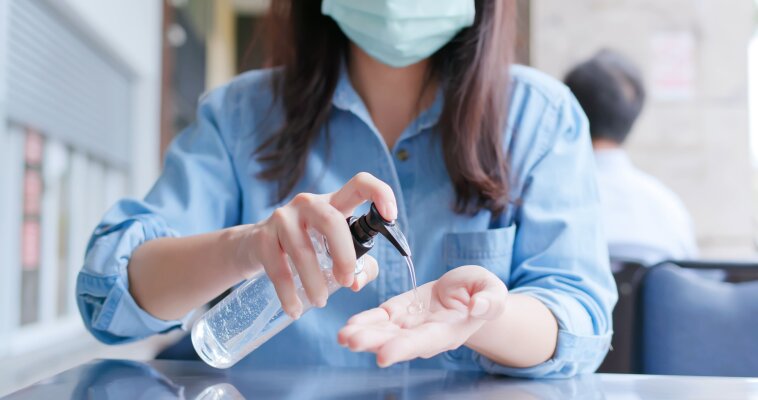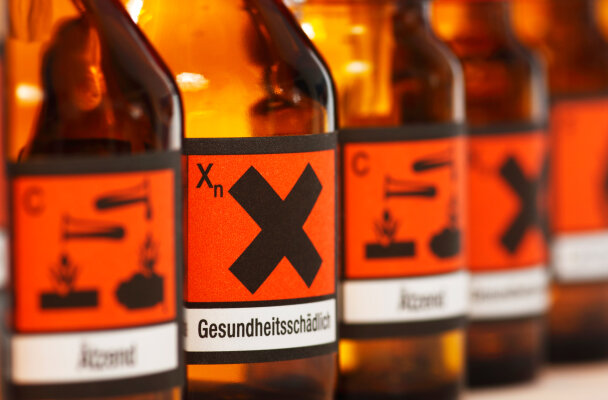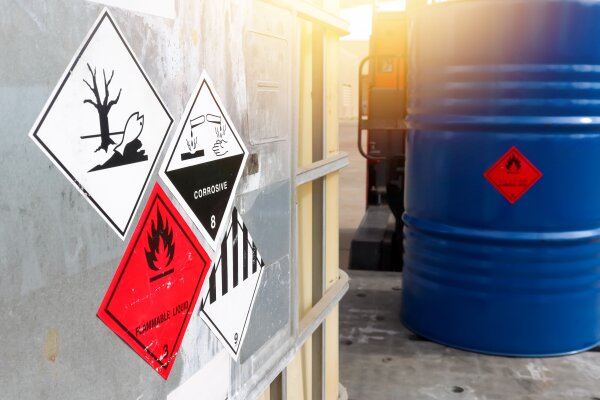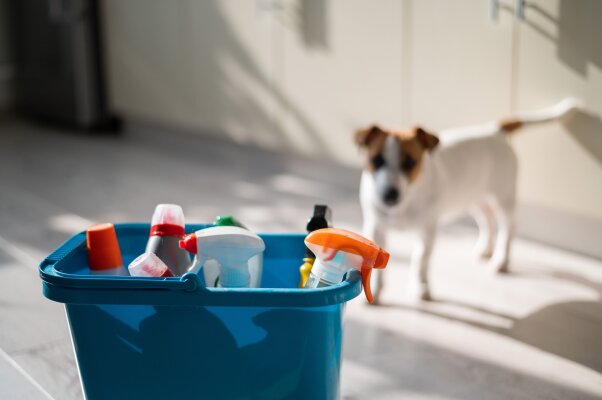Disinfectants: ingredients and health effects

Fungi, viruses and bacteria are an integral part of everyday life. Although they surround us constantly, only a few representatives are actually harmful to human health – these are called pathogens. Surface and hand disinfectants are used to control exposure to these microorganisms.
This overview summarizes which disinfectant ingredients are contained, what needs to be taken into account in terms of health, and what proper application looks like.
Disinfectant for hands: Ingredients
Disinfectants can be divided into different areas of application and types. When used on the hands, it is particularly important that the ingredients of the disinfectants are well tolerated andideally also nourishing and regreasing. Such active ingredients prevent drying of the skin surface and thus dry and cracked skin.
For hand disinfectants, ingredients such as alcohols, sporicides and humectants are commonly used. While alcohols have a disinfecting effect against bacteria, fungi and non-enveloped bacteria, sporicides additionally kill spores. Humectants protect the skin from drying out.
In addition, polyguanides, aldehydes, halogens, ammonium compounds and bipyridines are often found. These also have bactericidal, virucidal, fungicidal and sporicidal properties and are suitable for use on the skin.
Disinfectant ingredients and their effects:
| Ingredients | Effect |
| Alcohol | bactericide, limited virucide, fungicide |
| Sporicides | sporicides |
| Humectant | Protects the skin from drying out |
| Polyguanide | antibacterial properties; attracts bacteria through a negative charge |
| Aldehydes | fungicidal, bactericidal, virucidal; additionally also conditionally sporicidal |
| Halogenated | fungicide, bactericide, virucid, sporicide |
| Bipyridines | bactericidal, fungicidal, virucidal |
| Ammonium | compounds germicidal |
| Polihexanide | bactericide and fungicide; antimicrobial hand and skin cleanser. |
In disinfectants for hands, the individual substance groups can be present in different compositions and versions. Common representatives of the individual categories of active ingredients are, in particular, the following:
- Alcohols: B. Ethanol, Propan-1-ol, Propan-2-ol
- Sporicides: B. Hydrogen peroxide, peracetic acid
- Humectant: B. Glycerin or glycerol
- Polyguanid: B. Chlorhexidin
- Aldehydes:e.g. formaldehyde (now only very rarely used due to health concerns)
- Halogens: B. Chlorine or chlorine dioxide, iodine
- Bipyridine:B. Octenidin bzw. Octenidindihydrochlorid
- Ammonium compounds: B. Mecetronium ethyl sulfate
Example: Ingredients in Sterillium disinfectant
To illustrate the composition of the ingredients of a disinfectant, the products of the Sterillium brandare used here as an example. The composition of this disinfectant for hands is specified by the manufacturer as follows:
- Propan-2-ol
- Propan-1-ol
- 1-Tetradecanol
- Mecetronium etilsulfate
Composition of disinfectant for surfaces
Not only in hospitals and other health care facilities, but also in the private sector, the disinfection of surfaces is elementary. This is because with appropriate hygiene, a chain of infection with potential pathogens can be prevented before any skin contact can even take place.
Usually a wipe disinfection is recommended, which is partly done via special disinfection wipes. This avoidance of sprays can prevent small disinfectant droplets from entering the lungs, which can have negative health effects.
As for the disinfectant ingredients in hand disinfection, alcohols are mainly included on the list. Here it is important to ensure compatibility -with the surface material. In addition, there are various ingredients for different spectrums of action, which may include, above all, ammonium compounds, aldehydes, peroxide compounds and glycol derivatives:
| Ingredients | Effect | Common tools |
| Aledyhde | Bactericide, Fungicide, Virucide, Sporicide | e.g. glutaraldehyde, formaldehyde (however potentially harmful to health) |
| Alcohols | bactericidal, limited virucidal, fungicidal | e.g. ethanol, propan-1-ol, propan-2-ol, dichlorobenzyl alcohol |
| Peroxide compound | sporicidal | e.g. peracetic acid, hydrogen peroxide, sodium perborate |
| Quaternary ammonium compounds | bactericidal, fungicidal, virucidal; they are less harmful to health than aldehydes, which is why they are increasingly replacing them | s.a. Benzalkonium chloride, Octenidin, Cetalkonium chloride |
| Guanidine | bactericidal | e.g. polyhexamethylene biguanidine (PHMB), chlorhexidine, hexamidine |
| Phenols | bactericidal | Cresol, Phenol, Thymol |
| Halogens | fungicide, bactericide, virucide, sporicide | e.g. chlorine or chlorine dioxide, iodine |
Unlike hand disinfectant, surface disinfectant ingredients do not contain humectants - the corresponding effect would simply not make sense for surfaces. For this purpose, some agents contain perfumes that are supposed to provide a pleasant scent. Fragrances, on the other hand, are not used in hand disinfection, as they can be potentially allergenic.
Example: Ingredients in Sagrotan disinfectant
Like Sterilium, Sagrotan is one of the better-known brands and offers, for example, hygiene sprays for surfaces or disinfectant cleaners and wipes. Most products contain:
- Ethanol (between 1.2 and 63 grams per 100 grams of product)
- 2-Propanol
- Disinfectant (without more detailed information on composition)
- Fragrances
Ingredients of disinfectants - harmful to health?
In connection with the disinfection of hands and surfaces, the question frequently arises as to whether the disinfectant ingredients used can have a harmful effect on health. Although possible hazardous properties may exist, the actual hazard situation is rather low according to studies and scientific publications.
Proper application in particular can already significantly reduce potential hazards. Adverse health effects are most likely to occur if certain disinfectant ingredients have been used or if there is a general sensitivity to the active ingredients.
Possible hazardous properties
If one follows the opinion of the Industry Association for Hygiene & Surface Protection (IHO), the usual active ingredients such as ethanol or isopropanol offer no documented evidence of carcinogenic, mutagenic or reproductive effects. Resistance is also not known. Only local skin damage can result from frequent use.
However, various disinfectant ingredients, which are now often not used at all, can cause physical reactions. The actual effects differ depending on how high and frequent the exposure is. According to the current CLP Regulation, the hazards of the active substances are classified per substance group, which allows the intrinsic hazards to be compared:
- carcinogenic
- irritant
- sensitizing
- caustic
- toxic
- Triggers of allergic reactions
- mutagenic
Assessment of the hazard situation of various ingredients
When looking at the ingredients of modern disinfectants, however, it quickly becomes apparent that hazardous active ingredients are almost impossible to find. This is also confirmed by the current risk assessmentlinked by the Robert Koch Institute (RKI). According to BGW, a hazardous situation exists for the following ingredients:
| Ingredient | Possible hazard situation |
| Formaldehyde (practically no longer found in disinfectants) | genotoxic, carcinogenic, irritant |
| Chlorhexidine | Disturbance of the skin barrier and drying of the skin; sensitizing |
| Sodium hypochlorite | irritant to skin and mucous membranes |
| Iodinated polyvinylpyrrolidone | rarely triggers allergic reactions |
| Quaternary ammonium compounds | irritant and sensitizing |
| Alkylamines | corrosive; triggers allergic reactions |
| Glyoxal | mutagenic |
Correct use of disinfectants
To ensure optimal disinfection and at the same time reduce the risk of potential health hazards, proper use of disinfectants is essential. It is important to distinguish between hand disinfectants and surface disinfectants and to pay attention to their shelf life: If they have expired, they should not be used. The same also applies if there is obvious contamination by foreign substances and liquids.
Hand disinfectant
The following measures have proven to be particularly effective for hand disinfection:
- Apply the disinfectant to dry palms and use a sufficient amount according to the manufacturer's instructions.
- Rub your hands for about 30 seconds to allow the remedy to work thoroughly.
- Be sure to use the correct rub-in technique - this is the only way to ensure that all surfaces have been covered.
- Do not dilute the disinfectant by washing your hands directly before or after it, for example.
Surface disinfectant
In surface disinfection, a distinction is made between wipe disinfection and spray disinfection. However, for both variants, the following precautions should be observed:
- Wear glovesto protect your skin from potentially harmful effects.
- Make sure that the surface is sufficiently wetted. Otherwise, harmful microorganisms may remain.
- Be careful not to inhale the fine mist of spray disinfectants to avoid irritating your lungs.
- It is best to use disposable wipes for wipe disinfections and throw them away after use. Never immerse a used cloth in the agent again to avoid contamination.
Composition of disinfectants according to WHO formulation
The World Health Organization (WHO) has now published its own formulation that allows the production of effective disinfectants for doctors and pharmacists.
Although it is a list of disinfectant ingredients along with instructions for its production, this disinfectant should not be produced by a layman at home: It contains potentially flammable substances that require expertise. The ingredients according to the WHO formulation are as follows:
- Ethanol (96%) or isopropanol (99.8%)
- Hydrogen peroxide (3%)
- Glycerol (98%)
- Distilled water or boiled and cooled water
In addition, step-by-step instructions are included to facilitate production: The alcohol is poured into a plastic or glass container and then filled with the distilled water to 10 liters. Then the hydrogen peroxide is added.
The mixture is gently shaken before the glycerol is added. Finally, the plastic bottles with 500 or 100 milliliter capacities are filled. After 72 hours, the home-made disinfectant is ready for use - in the meantime, any spores that may still have been in the container have been killed.
Disinfectants: ingredients vary depending on the type
Disinfectant ingredients can vary greatly - depending on the purpose for which they are to be used. In hand disinfection, skin compatibility is based on humectants, while aldehydic components are more frequently found in surface disinfection. Depending on your sensitivity, you should find and use the right products for you.
Frequently asked questions about the composition of disinfectants
The most important components of disinfectants are alcohols, which usually account for between 60% and 95% of the total product by volume. Common alcohols are mainly ethanol, 1-propanol and 2-propanol. The latter is also known as isopropanol.
Halogens are also present in surface disinfection, which contribute to the denaturation of numerous structuresand are therefore rather poorly tolerated by the human organism. Common representatives of these disinfectant ingredients are halogens such as chlorine, fluorine or iodine.
In case of excessive use of disinfectants, it is possible that health consequences may occur. This may be due to ingredients such as fragrances and aldehydes, which in rare cases can trigger allergies or cause irritation in sensitive skin.
Do you have questions about the topic or would you like to suggest a topic? Please feel free to contact us by phone at +49 30 2096579 00 or send us an email to info@medsolut.com.




